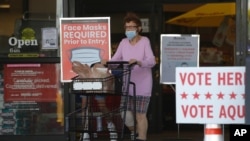The novel coronavirus pandemic has reached a new milestone, with more than 12 million confirmed infections, according to the online tracker created by Johns Hopkins University.
The United States leads the world’s countries with the most confirmed COVID-19 infections at 3,054,695 — a fourth of the world’s total — including more than 60,000 new cases on Wednesday, the biggest single-day number since the outbreak began.
At least five states — California, Texas, Tennessee, West Virginia and Utah — posted a record number of new cases Wednesday, while several states reached records for new cases over a seven-day period. Health officials in Arizona, California, Florida and Texas are also warning that hospitals across their states have reached or are nearing full capacity in their intensive care units.
The U.S. is also the world leader in COVID-19 deaths, with well over 132,500, about one-quarter of the 550,600 fatalities worldwide.
Meanwhile, the World Health Organization launched an independent panel Thursday to evaluate its response to the pandemic. WHO chief Tedros Adhanom Ghebreyesus said at a regular briefing in Geneva the Independent panel for Pandemic Preparedness and Response will allow the world to “understand the truth of what happened and also the solutions to build our future better as one humanity.”
Tedros’ announcement came after U.S. President Donald Trump, who has criticized the global public health agency’s response to the pandemic, formally started withdrawing from the WHO on Tuesday, sparking outrage from public health advocates and political opponents.
Tedros also warned world leaders of even more dire consequences if they do not act quickly to heal divisions in the global community.
“The greatest threat that we face now is not the virus itself — rather, it is the lack of leadership and solidarity at the global and national levels,” Tedros said. “We cannot defeat this pandemic as a divided world. The virus thrives on division but is thwarted when we unite.”
In Australia, five million residents in the country’s second-largest city of Melbourne began a six-week lockdown at midnight local time Wednesday due to an alarming spike of new COVID-19 cases.
Residents have been ordered to stay home unless going to work, school, medical appointments or shopping for food. City officials had already imposed stay-at-home orders in at least 30 neighborhoods and a “hard” lockdown of nine public housing towers, home to over 3,000 residents, where 23 COVID-19 cases have been detected among 12 households.
The total lockdown comes just days after officials in the neighboring states of Victoria and New South Wales closed their shared border after Melbourne, Victoria’s capital city, reported 127 new coronavirus cases on Monday.
In Japan, public broadcaster NHK is reporting that Tokyo has recorded 224 new cases of COVID-19 infections on Thursday, a new one-day record for the capital city.
A study released Thursday said there is “strong evidence” that mothers who have contracted COVID-19 can pass the virus onto their unborn children.
Researchers in Italy discovered the virus and antibodies in the placentas, umbilical cords, breast milk and the vaginas of 31 pregnant women who were hospitalized with COVID-19.
The findings are the strongest evidence yet the coronavirus can be transmitted between mother and infant.
University of Milan immunology assistant professor and lead author of the study, Claudio Fenizia, said the findings “strongly suggest” that in-vitro transmission of the virus is possible, but emphasized that none of the infants born during the study period tested positive for COVID-19.
Another study, published Wednesday in the scientific journal Nature, has found that older people, men, racial and ethnic minorities and those with pre-existing health conditions such as obesity, diabetes and severe asthma are more likely to die from COVID-19.
The study was conducted by a team of British researchers who tracked over 17 million patients over three months. They found that of the more than 10,000 people who died of COVID-19 or COVID-19 related complications, patients 80 years old or older were a least 20 times more like to die from the disease than those in their 50s, and hundreds of times more likely to die than those below the age of 40.
The researchers also found that roughly 11 percent of the total number of patients tracked in the survey identified as non-white, and that these patients — particularly Black and South Asian — were at higher risk of dying from coronavirus than white patients.











